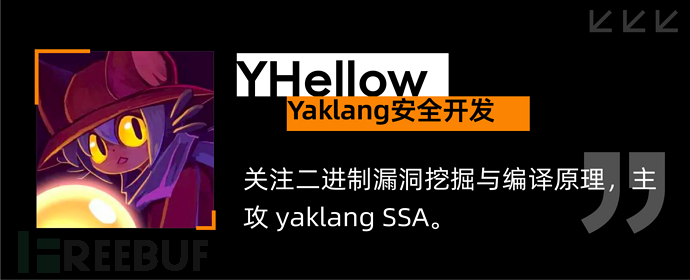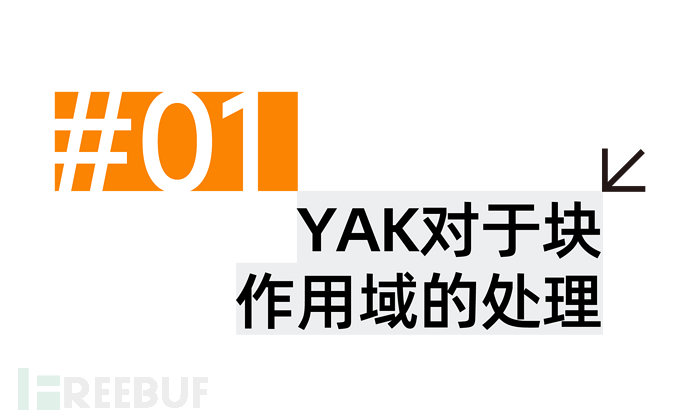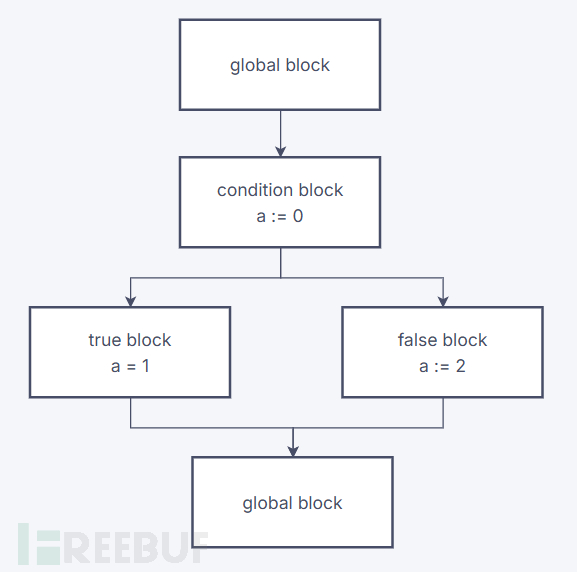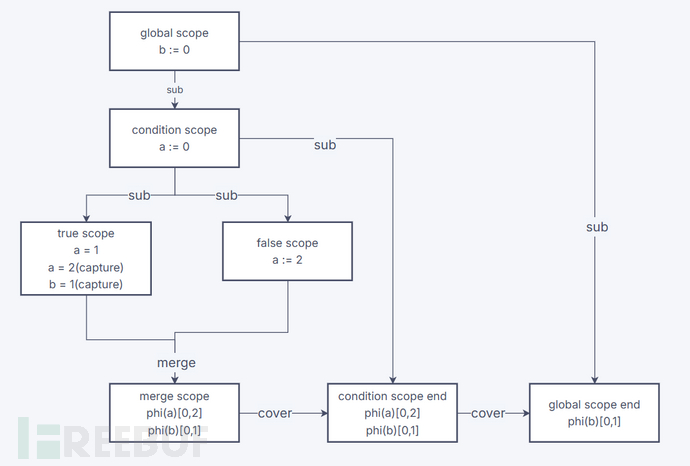家人们下午好呀
这里是超绝脱单牛一枚
没错,我和Yaker有一个孩子(bushi
今天我们的孩子YakLang来给大家介绍介绍,ta对块作用域的处理方式



在编程中,作用域(Scope)指的是变量、函数和对象的可访问性和生命周期的范围。不同的编程语言可能对作用域有不同的定义和实现。
块级作用域(Block Scope)是指在代码块(如条件语句、循环、函数等)内部定义的变量仅在该块内可访问的特性。这一概念在许多现代高级编程语言中得到了广泛应用。
那么在 yaklang 中是如何处理块级作用域的呢?
首先查看如下的 golang if 语句
if a := 0; a > 0 { a = 1 } else { a := 2 }
可以发现,上述代码实际上形成了如下的 block 结构:

想必细心的同学已经发现了,在 true block 中的表达式会影响外部的 global block 并且生成 phi 值,而 false block 则不会。
那么 yaklang 是如何区分是否生成 phi 的呢?这就涉及到了 scope 的3种常规操作:sub,merge,cover。

Phi值是什么?
在编程语言和编译器设计中,phi 值(φ 值)是一种用于静态单赋值形式(Static Single Assignment, SSA)中的概念
当控制流图中的某个节点(如条件分支)需要根据不同的路径选择变量的值时就会生成 phi 值,phi 值用于描述一个变量在当前作用域中可能存在的所有值
Scope 常规操作:
Sub(产生子作用域)
定义:以一个 scope 为父类,产生该 scope 的子作用域(在查找变量时可以通过_parent 指针索引到父类 scope)。
实例:
if a := 1; a > 0 { // condition block sub true block println(a) // 1 }
Cover(覆盖)
定义:当一个变量在内部 scope 被重新赋值时,内部作用域的变量将“覆盖”外部作用域中同名的变量。这意味着在内部作用域中,引用该变量时将使用新定义的值。
实例:
a := 1 { a = 2 // true block cover to condition block } println(a) // 2
Merge(合并)
定义:在作用域中,合并通常指将多个作用域中的变量或命名空间组合在一起,以便可以访问所有变量。这种合并可能发生在不同的作用域级别之间,特别是在模块或命名空间中。
实例:
if a > 0 { a = 1 } else { a = 2 } // true block, false block merge to global block println(a) // phi(a)[1,2]
简单来说,cover 会使非本地的变量影响到外部,而 merge 则会合并多个 scope 以生成 phi 值。
yaklang 中的 local value
在 yaklang 中有一个 local 标志位来记录变量是否在当前作用域中创建,还是这个例子:
if a := 0 /* local value(condition block) */; a > 0 { a = 1 /* not local value(true block) */ a = 2 /* not local value(true block) */ } else { a := 3 /* local value(false block) */ }
如果在某个 scope 中产生了一个非本地变量,那么在当前 scope 中将会生成一个 capture value,而 merge 正是通过 capture value 来生产 phi 值的。

了解了以上知识以后,我们来看一个复杂一点的案例:
if a := 0; a > 0 { a = 1 a = 2 b = 1 } else { a := 2 } println(a) // undefined println(b) // phi(b)[0,1]
详细的处理过程如下:
首先从 global scope 中 sub 一个 condition scope,然后再分别从 condition scope 中 sub true scope 和 false scope。
在 true scope 中存在非本地变量 “a” 与 “b”,然后分别生成对应的 capture value(capture value 会记录当前 scope 中非本地变量的最后一次赋值)。
当 true block 和 false block 都处理完毕以后,程序就会将 true scope 和 false scope merge 到一起,由于检测到 capture value,因此会生成 phi 值(分别是 phi(a)[0,2] 和 phi(b)[0,1])。
在 yaklang 中,最后两步处理比较特殊:
程序会选择在 condition scope 中 sub 一个新的 scope(condition scope end),然后将 merge 后的 scope 直接 cover 到新的 scope 上。
接着从 global scope 中 sub 一个新的 scope(global scope end),然后将之前 cover 后的 scope 直接 cover 到该 scope 上。
这样处理的目的是为了确保最后生成的 global scope end 是 global scope 的直接子类(没有任何的中间 scope)。
流程图如下:

PS:从代码层面来看,流程图可能有所不同,因为在我们实际的代码中 merge 方法里面包含了 cover 的代码,因此在代码流程图中没有 merge scope 这一步。
最后形成如下结构:
if-condition : condition true -> if-true false -> if-false if-true: body if-true -> if-done if-false: // else or else-if (else-body) ( condition true -> if-true2 false-> if-false2 ) if-false -> if-done if-done: // next code
对于一个 if 语句而言,yaklang 将其 scope 分为了3个大的部分:global scope,if scope,if scope end:
if scope 和 if scope end 都以 global scope 为父类
if scope end 被 if scope 所覆盖
最后在 if 语句执行完毕以后,将当前作用域标记为 if scope end。
实际上的处理也应该是这样:
if 语句后的代码可以通过父类的 global scope 查找到 global scope 中的变量
在 if scope 中对外部作用域的影响(例如生成 phi 值)被 cover 到当前作用域中(if scope end)
我们可以利用 yaklang 跑一个 golang 的代码,查看 yaklang 对于块作用域的处理效果:
func TestTemp(t *testing.T) { t.Run("temp", func(t *testing.T) { test.CheckPrintlnValue(`package main import "fmt" func main() { b := 0 if a := 0; a > 0 { a = 1 a = 2 b = 1 } else { a := 2 } println(a) // undefined println(b) // phi(b)[0,1] } `, []string{"Undefined-a","phi(b)[1,0]"}, t) }) }
package: main library @init type: (any) -> any entry-0: extern type: main type: () -> null entry-0: jump -> if-condition-1 if-condition-1: <- entry-0 <boolean> t22 = <number> 0 gt <number> 0 If [<boolean> false] true -> if.true-2, false -> if.false-3 if.true-2: <- if-condition-1 jump -> if.done-4 if.false-3: <- if-condition-1 jump -> if.done-4 if.done-4: <- if.true-2 if.false-3 <any> t33 = phi [<number> 1, if.true-2] [<number> 0, entry-0] <any> t34 = phi [<number> 2, if.true-2] [<number> 0, if-condition-1] <any> t36 = undefined-a <number, error> t37 = call <func(...interface {}) (int, error)> println (<any> t36) binding[] member[] <number, error> t38 = call <func(...interface {}) (int, error)> println (<any> t33) binding[] member[] extern type: error: [ warn] (GO): not find variable a in current scope: 14:10 - 14:11: a Values: 1 0 (t35): [Function] Function-println 14:2 - 14:9: println Values: 2 0 (t37): [Call ] Function-println(Undefined-a) 14:2 - 14:12: println(a) 1 (t38): [Call ] Function-println(phi(b)[1,0]) 15:2 - 15:12: println(b) [INFO] 2024-09-19 13:20:49 [utils4frontend:135] got :[Undefined-a phi(b)[1,0]] [INFO] 2024-09-19 13:20:49 [utils4frontend:137] want :[Undefined-a phi(b)[1,0]]
可以发现,yaklang 不仅对块作用域有明确的标识,还分析了各个块的逻辑关系,生产的 phi 值也有明确的来源,最后在查找的过程中也区分开了变量 “a” 与变量 “b” 的作用域范围。
在 yaklang 中,目前已经对 if,loop,try-catch,switch,break,continue 都有了比较完善的处理,和对 goto 的部分处理(正在开发)。
END
YAK官方资源
Yak 语言官方教程:
https://yaklang.com/docs/intro/
Yakit 视频教程:
https://space.bilibili.com/437503777
Github下载地址:
https://github.com/yaklang/yakit
https://github.com/yaklang/yaklang
Yakit官网下载地址:
https://yaklang.com/
Yakit安装文档:
https://yaklang.com/products/download_and_install
Yakit使用文档:
https://yaklang.com/products/intro/
常见问题速查:
https://yaklang.com/products/FAQ
4A评测 - 免责申明
本站提供的一切软件、教程和内容信息仅限用于学习和研究目的。
不得将上述内容用于商业或者非法用途,否则一切后果请用户自负。
本站信息来自网络,版权争议与本站无关。您必须在下载后的24个小时之内,从您的电脑或手机中彻底删除上述内容。
如果您喜欢该程序,请支持正版,购买注册,得到更好的正版服务。如有侵权请邮件与我们联系处理。敬请谅解!
程序来源网络,不确保不包含木马病毒等危险内容,请在确保安全的情况下或使用虚拟机使用。
侵权违规投诉邮箱:4ablog168#gmail.com(#换成@)


